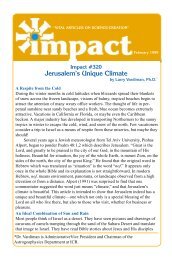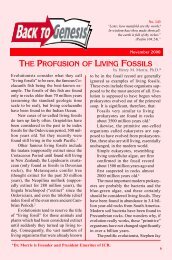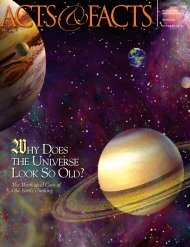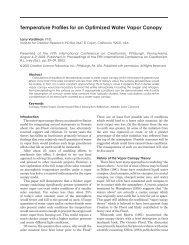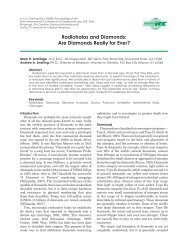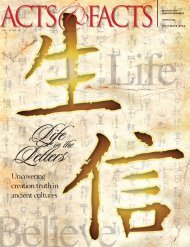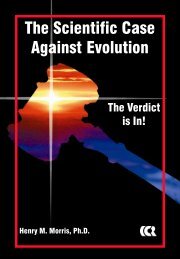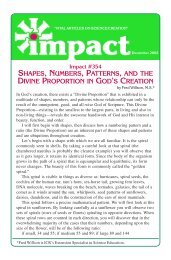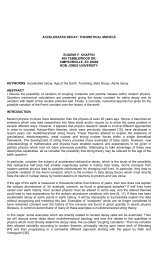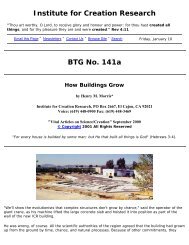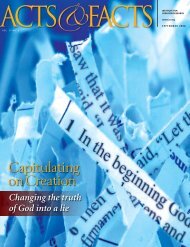Acts & Facts - Institute for Creation Research
Acts & Facts - Institute for Creation Research
Acts & Facts - Institute for Creation Research
You also want an ePaper? Increase the reach of your titles
YUMPU automatically turns print PDFs into web optimized ePapers that Google loves.
such a way that it is clear he was well-preparedwith “logic,” since he was “set <strong>for</strong> the defence[apologia] of the gospel” (Philippians 1:17).If we are to follow the biblical model <strong>for</strong>apologetics, we will first sanctify our hearts,and then become ready to respond with ananswer to all who ask us about our hope (thegospel—our salvation) with a sound “reason”given in a gentle and respectful manner.RelevanceThe only biblical reference to “relevance”indicates that believers should applythe knowledge, understanding, and wisdomof the Scriptures—to themselves (Proverbs2:2; 22:17; 23:12). Nothing in the Bible suggeststhat churches should accommodate theworld’s behavior or standards to the ministryof the kingdom. However, Paul’s commentthat he was “made all things to all men, that[he] might by all means save some” (1 Corinthians9:22) seems to endorse the type ofbroad accommodation seen among “seekerfriendly”church programs.But the context of that passage severelylimits what Paul is suggesting. He is under“constraint” to preach the gospel, is a servantof the gospel, and is willing to <strong>for</strong>go his right to“live of the gospel” (get paid). Paul’s personallimitations are self-imposed to enable him toenter in to every cultural situation and “by allmeans” (whatever gives him the most freedom)to preach the gospel and to “save some.”That is a very different purpose from slippinga gospel message into a crowd after drawingthem with methods and processes that blur thelines between holiness and worldliness.Yes, we must be aware of the needs ofour audience. Paul was very versatile in hisapproach. He started with the Bible when hespoke to the Jews—they knew the text. Hestarted with creation with the pagans and thesophisticated. He used his political, social, andacademic stature in other situations. He quotedScripture in every case. His focus was gettingtruth out—not being “related” to the population.Truth-driven prophets and preachersdid not try to please or appease the population.“We are made as the filth of the world, and arethe offscouring of all things unto this day”(1 Corinthians 4:13).The current use of “relevance” oftenbends the truth of the biblical message tomake it acceptable or easy to swallow. Whilewe must make sure the truth is heard, wemust never leave out or cover over parts ofthe truth that may be uncom<strong>for</strong>table <strong>for</strong> theaudience. The power to change lives does notcome through the messenger or the method,but through the written word of God (Romans10:17).EvidenceThe Bible contains two distinct applicationsof “evidence.” The Old Testamentemphasizes the physical evidence that documentsthe proof of something. The Hebrewword cepher is always used to describe “hard”evidence. Moses used Adam’s book (Genesis5:1) to document early history. Jeremiah hada deed and associated papers (Jeremiah 32:11-16) to prove his purchase of property. We oftenapply this concept with historical or scientificevidence.The New Testament emphasizes a “conviction”about an idea or belief. “Now faith isthe substance of things hoped <strong>for</strong>, the evidenceof things not seen” (Hebrews 11:1). The Greekwords elegchos and elegcho (verb <strong>for</strong>m) are alwaysused to mean “convince.” Faith is basedon evidence that is “not seen.” The eternaltruths that bring one to salvation cannot beseen (in contrast to the physical evidence emphasizedin the Old Testament), but they arepresented in such a way that one becomes convincedabout those truths.There are three fundamental “not seen”principles upon which our faith rests. The creationby our Creator-Savior took place whenno one was around to see it happening. Thesubstitutionary sacrifice of Jesus Christ on thecross involved eternal transactions in the bowelsof earth and in the courts of heaven—faroutside of the visual verification of any human.And the promises of eternal redemptionin the new heavens and new earth are justthat—promises! Yet all of those fundamentaldoctrines are part and parcel to the gospel thatwe are required to accept by faith.Only the Creator has the infinite powerand authority to save “to the uttermost”(Hebrews 7:25). God Himself recorded thecreation week. Jesus demonstrated ex nihilocreation works when He was on earth thatwe might have “evidence” of who He is (John14:11; 20:31). The very foundation of faith isbelief that the creation of the universe was accomplishedby the “word of God” (Hebrews11:3).Only the God-Man, the co-equal incarnatedSon of God, could be both the satisfactoryand sufficient Lamb of God. His sinless substitution<strong>for</strong> our death sentence (Romans 6:23)made “propitiation…<strong>for</strong> the sins of the wholeworld” (1 John 2:2). The resurrection was the“evidence” provided <strong>for</strong> us that “proved” God’sholiness was satisfied (<strong>Acts</strong> 17:31).Only the Creator-Savior-King can fulfillthe promises of a “new heaven and a newearth” (Isaiah 65:17; 2 Peter 3:13; Revelation21:1). Our hope can be defended with “evidence”because of the One upon whom and bywhom the promises are given.We are to use apologetics to defend ourhope by a reason given in gentle respect tothose who ask us <strong>for</strong> the evidence. The “notseen” truths of Scripture <strong>for</strong> God’s existencewill be clearly seen (Romans 1:20), and thespeech and knowledge of everyday reality(Psalm 19:1-4) can be used “to exhort and toconvince” (Titus 1:9) those who are “otherwiseminded” (Philippians 3:15).Evidence must be the foundation <strong>for</strong>apologetics. The absolute purpose <strong>for</strong> relevanceis to “declare his gloryamong the heathen; hismarvellous works amongall nations” (1 Chronicles16:24).Dr. Morris is Chief ExecutiveOfficer of the <strong>Institute</strong> <strong>for</strong><strong>Creation</strong> <strong>Research</strong>.SEPTEMBER 2012 • ACTS&FACTS5
RESEARCHBio-Origins Project UpdateComparing 2,000 AnimalSpecies MolecularlyN a t h a n i e l T . J e a n s o n , P h .D.If you were to compare DNA across diverse species, what patternwould you expect to see? The Bio-Origins project at ICR has narrowedits focus to DNA to answer several major creation biologyquestions. We want to: 1) identify the created kind boundaries; 12) identify the mechanism by which the kinds underwent diversificationinto the vast array of species we see today; 2 and 3) identify the biologicalreason why the diversification process is limited to change within kinds. 3We also want to gather evidence against the faulty evolutionary paradigmepitomized by the “tree of life.” 4How would you attempt to answer these questions using DNA asa tool? Would you expect to find a “signature” in DNA that marks whichspecies belong to which kinds? Would you expect to find discontinuitythat depicts every species as isolated and unique from every other species?5 Perhaps a signature that genetic change started recently (in the pastfew thousand years)?As we hypothesize answers to these questions and try to test them,it is helpful to take stock of what we know about species’ origins. First, weknow that species undergo change—you don’t look exactly like your parents.Second, we know how fast (at present) change occurs. For example,we know, on average, how many mutations occur each generation in humans.Third, we know from Scripture that change has happened <strong>for</strong> only6,000-10,000 years, not <strong>for</strong> millions of years (as evolution posits). Fourth,we know that species have descended from the kinds that God createdduring the creation week.This knowledge creates a framework in which we can identify underlyingassumptions about DNA change that must be addressed be<strong>for</strong>eour bigger questions can be answered. Several unknowns are apparent.We don’t know what DNA sequences were present in the originalkinds that God created during the creation week of Genesis 1. DidGod create each DNA sequence unique to each kind? Or did He re-usegene sequences (subsets of DNA sequences) in different creatures? Forexample, when creating a gene involved in bone <strong>for</strong>mation (let’s hypotheticallycall the gene boneF1), did He place the same gene sequence <strong>for</strong>boneF1 in all vertebrates, or did He uniquely tailor the boneF1 sequenceto each kind?We also don’t know if DNA changes since creation occurred randomlyor deterministically. Were changes designed to occur in specificregions of the genome, or did they occur haphazardly?Another unknown is the rate of change in each species—was itconstant or variable? Was there a burst of change post-Flood followed bya slow-down to the present day, or was change constant over every species’history? All of these assumptions need to be explored be<strong>for</strong>e we canuse DNA comparisons to answer our bigger creation biology questions.So, what would we expect the pattern of DNA similarities and differencesto be across diverse species? Our molecular studies so far have(tentatively) revealed an intriguing phenomenon. We have comparedDNA and protein sequences across ~2,000 species of animals, and, pendingpeer review, these comparisons naturally lump species into groupsthat match traditional classification categories based on anatomy andphysiology. What do these results imply about the origin of these sequencesin these species? Stay tuned to this column as we try to answerthis question!References1. Jeanson, N. 2010. Common Ancestry and the Bible—DiscerningWhere to Draw the Line. <strong>Acts</strong> & <strong>Facts</strong>. 39 (6): 6.2. Jeanson, N. 2010. The Impetus <strong>for</strong> Biological Change. <strong>Acts</strong> &<strong>Facts</strong>. 39 (8): 6.3. Jeanson, N. 2010. The Limit to Biological Change. <strong>Acts</strong> & <strong>Facts</strong>.39 (7): 6.4. Jeanson, N. 2010. New Frontiers in Animal Classification. <strong>Acts</strong> &<strong>Facts</strong>. 39 (5): 6.5. Jeanson, N. 2011. Molecular Equidistance: The Echo of Discontinuity?<strong>Acts</strong> & <strong>Facts</strong>. 40 (2): 6.Dr. Jeanson is <strong>Research</strong> Associate and received his Ph.D. in Celland Developmental Biology from Harvard University.6 ACTS&FACTS • SEPTEMBER 2012
EVENTSICR SEPTEMBER EVENTSn SEPTEMBER 20-22Indianapolis, INTrue Woman Conference 2012info@TrueWoman.comn SEPTEMBER 26-28Myrtle Beach, SCSoutheast Christian SchoolConvention(J. Morris) www.ncssa.orgn SEPTEMBER 28-29Johnson City, TNGod’s True North: Worldview on theFamily Conference 2012(H. Morris III, J. Morris,R. Guliuzza) 423.741.1663For more in<strong>for</strong>mation on these events or to schedule an event, please contact the ICR Events Department at 800.337.0375 or events@icr.org.September 28-29, 2012 • Johnson City, TennesseeHear three of ICR’s top speakersaddress current issues in light of theBible, creation, and the family. JoinDr. Henry Morris III, Dr. John Morris,and Dr. Randy Guliuzza <strong>for</strong> insightfulpresentations on Genesis and howthe book of beginnings impacts ourlives today, both as individuals andas families.For more in<strong>for</strong>mation or to register,visit www.WorldviewontheFamily.orgDr. Henry Morris III Dr. John Morris Dr. Randy GuliuzzaSEPTEMBER 2012 • ACTS&FACTS 7
Real World ApologeticsTaking the Initiative to Communicate TruthGod likes variety—more variety than we can fullyappreciate, even if we had multiple lifetimes toinvestigate His creation! Here are two proofs:1) Scripture shows that variety matches God’sdivine nature and how He made mankind in His own image,and 2) God’s physical non-human creation shows that Godsupernaturally selected and favors variety.Nature displays differences in details of diverse animals,plants, microorganisms, earth’s geophysical environment, andeven the innumerable galaxies of outer space.Being Made in God’s Image Includes Appreciating VarietyOur first clue that God values variety is the Bible’s firstverse: “In the beginning God created the heaven and the earth”(Genesis 1:1).As noted in previous articles, the Hebrew subject nountranslated “God” (Elohîm) is plural, yet its action verb, “created”(bara’), is singular 1 —our first indication that the Creator-Godof the Bible is a plural-yet-one Being. Thus, variety isactually part of God’s plural-yet-one essence! No wonder Godappreciates variety—it is part of His divine nature!Unsurprisingly, God designed variety into humanitywhen God chose to make Adam and Eve in His own image.The first diversity among humans was the dichotomy of maleand female:So God created man in his own image, in the image ofGod created he him; male and female created he them.(Genesis 1:27)But the diversity God designed <strong>for</strong> humanity goes farbeyond gender. People belong to different tribes, nations, andgenetic-ethnic groups. These varied backgrounds are definedand recognized by myriads of details, including language andappearance, setting the stage <strong>for</strong> a choir of redeemed humans,selected from multifarious people-groups:And they sung a new song, saying, Thou art worthy totake the book, and to open the seals thereof: <strong>for</strong> thou wastslain, and hast redeemed us to God by thy blood out ofevery kindred, and tongue, and people, and nation. (Revelation5:9)God did not limit His provision of diversity to Adam andEve’s extended family. God programmed variety into animals(platypuses and plesiosaurs), plants (pansies and pines), andtiny microorganisms (Paramecium protozoa and Pseudomonasbacteria). Also, non-living components of God’s creationdisplay geophysical diversity (glaciers and granite, fjords andfelsenmeer, snowflakes and sand dunes) and even astrophysicaldiversity (planets and pulsars, supernovas and spiral galaxies).God’s vast display of diversity in creation demonstrateshow much He prizes variety.Biodiversity: From Eden’s Garden, to Noah’s Ark, to theEarth of Today“Biodiversity” is the scientific word used to summarizethe variety of life <strong>for</strong>ms on earth. Noah’s Ark, which God usedto caringly preserve the genetic potential <strong>for</strong> post-Flood biodiversity,is proof that God loves biodiversity.In fact, the countless variations that God designed andbuilt into plants, animals, and microorganisms utterly exhauststhe imaginations and observation capabilities of eventhe most learned empirical scientists.How does God showcase variety in the animal kingdom?Think alphabetically: aardvarks, bears, coyotes, dinosaurs,echinoderms, frogs, geese, hyenas, ice worms, jellyfish, kangaroos,lions…and zebras!Different animal types are recognized by morphological(body structure) distinctives. 2 Some are quadrupeds (minks,marmots, muskrats, and mice). Others have two feet and twowings (roosters, ratites, and red-winged blackbirds). Othershave fins or flippers (seals, sharks, salmon, and swordfish).Others have prehensile trunks or tentacles (elephants and octopi).Others live in shells (snails, shrimp, and snapping turtles).Still others have tube-shaped bodies (cutworms, caterpillars,and copperheads).Different reproductive habits exhibit variety in animals.Some lay eggs, while others do not. Gestation times and littersizes vary.Caribou (Rangifer tarandus—reindeer) usually matein summer or fall, producing one baby the following springValuing God’sVarietyJames J. S. Johnson, J.D., Th .D.8 ACTS&FACTS • SEPTEMBER 2012
or summer. 3 Yellow-bellied marmots (Marmota flaviventris) usuallymate in spring, producing a litter of two to five babies about a monthlater. 3 Dungeness crab (Cancer magister) usually mate in summer,with a million-plus fertilized eggs hatching about four months later. 4The contrasting reproductivity of codfish and chickens hasbeen observed and humorously heralded in this poem:The codfish lays a thousand eggsthe homely hen but one.The codfish never cacklesto tell you what she’s done.And so we scorn the codfishwhile the humble hen we prize,Which only goes to show youthat it pays to advertise. 5Consider these different instinctive or learned behaviors: arcticterns migrate from the arctic to the antarctic and back; octopi use onand-offcamouflage; schools of fish swim in choreographed harmony;parrots mimic human speech and other sounds; bears hibernate inwinter; marmots whistle to one another; sleeping hummingbirds slowtheir metabolic rates; prairie dogs tunnel; pregnant lobsters becomeaggressive; loggerhead shrikes impale their prey; and eagles wait <strong>for</strong>rising thermal air currents (as if they were elevators).Different habitats constitute year-round or seasonal domiciles<strong>for</strong> God’s animal creatures: jungle, glacier, desert, bog, swamp, juniper-pinyon“pygmy” <strong>for</strong>est, prairie, tundra, taiga, ocean, pond, canyon,river, estuary, saltmarsh, island, and more.Likewise, a survey of the plant kingdom illustrates God’s appreciation<strong>for</strong> variety: evergreen and deciduous trees, cacti, shrubs,flowers, grasses, legumes, root vegetables, herbs, and mosses. Flowersalone provide more than a lifetime of opportunities to investigate andappreciate variety.Even humble microorganisms—unseen by unaided humaneyes—exhibit God’s creative provision of innovative details and uncountabledifferences. Careful microscopy is required just to glimpsethese little wonders—bacteria, protozoa, and viruses. Miniature galaxiesof eukaryotic cell organelles and infrastructure details becomevisible with light microscopes, transmission electron microscopes,and scanning electron microscopes.Who Did the “Selection” in Nature?But the biodiversity we see today does not match evolutionarypredictions. Evolutionary assumptions imagine a scenario in whichall life <strong>for</strong>ms, gradually branching off from common ancestors, somehowend up as a biotic community that amounts to one big familyreunion with everything and everyone being interlinked “cousins.”But reality is different—sharp biodiversity boundary lines betweencreated kinds exist, and the “missing links” between intra-breedablekinds are still missing. If Darwin-presumed “missing links” ever reallyexisted, why are they still missing? 6Canines (dogs, coyotes, wolves, and foxes) are genetically compatible—theycan all interbreed. Likewise, bears (black bears, grizzlies,and even polar bears) can interbreed. But canines and bears cannot—there’s no common ancestor “link” here!If evolution were really true, as evolutionists imagine, the earthshould be inundated with common-ancestry “transitional <strong>for</strong>ms,” evidencedby both fossils and living life <strong>for</strong>ms with no sharp biodiversityboundaries between the inter-breedable kinds. 6However, the real world of nature (as shown by fossils and bytoday’s biotic communities) corroborates the Bible’s account of biodiversity—includingthe historic fact that the greatest biodiversity conservationproject ever was the preservation of “kinds” aboard the goodship Ark. 7God’s appreciation <strong>for</strong> variety is “clearly seen” in His creation.So when it comes to earth’s biodiversity, vivent les differences—becauseGod loves variety!References1. Johnson, J. J. S. 2012. Biblical Truth in High Definition. <strong>Acts</strong> & <strong>Facts</strong>. 41 (8): 9-10.2. Taxonomy is the empirical science of observing, analyzing, and categorizing living things,but these categorizations are vulnerable to limitations of human arbitrariness and subjectivepreferences (e.g., “lumpers” versus “splitters”), sometimes to the skewed extreme ofevidencing political biases. Lepidopterist Harry Zirlin observes: “In the spring of 2005, twotaxonomists…named three newly described slime-mold beetles after President Bush, VicePresident Cheney, and then Secretary of Defense Rumsfeld. Although the two taxonomistsinsisted that they intended it as an honor <strong>for</strong> these men to have their names attached toposterity to three species of slime-feeding beetles in the genus Agathidium (A. bushi; A.cheneyi; and A. rumsfeldi) there was nevertheless some snickering in the press.” Zirlin, H.2007. Taxonomists Just Wanna Have Fun: When Good Taxonomists Go Bad. AmericanButterflies. 15 (1/2): 58.3. Hayssen, V., A. van Tienhoven, and A. van Tienhoven. 1993. Asdell’s Patterns of MammalianReproduction. Ithaca: Cornell University Press, 390-415 (caribou), 463-489 (marmot).4. Bliss, D. 1990. Shrimps, Lobsters, and Crabs: Their FascinatingLife Story. New York: Columbia University Press, 134-135.5. Kurlansky, M. 1998. Cod: A Biography of the Fish ThatChanged the World. London: Penguin Books, 29.6. Morris, J. 2006. What’s a Missing Link? <strong>Acts</strong> & <strong>Facts</strong>. 35 (4);Johnson, J. J. S. 2008. The Evidence of Nothing: The SilentWitness of Evolution’s Missing Links. <strong>Acts</strong> & <strong>Facts</strong>. 37 (4):4-5.7. Genesis 6-9.Dr. Johnson is Associate Professor of Apologetics and ChiefAcademic Officer at the <strong>Institute</strong> <strong>for</strong> <strong>Creation</strong> <strong>Research</strong>.SEPTEMBER 2012 • ACTS&FACTS9
The heavens declare…The Stargazer’s Guideto the Night Skyby Dr. Jason LisleIf you ever looked up into the night sky andwanted to know more about what you are seeing,this book is <strong>for</strong> you.“There is something about the night sky thatcaptures our imagination and evokes a sense of aweand wonder. And our appreciation of the magnificenceof creation is enhanced as we learn moreabout the cosmos. But what many people do notrealize is that many of these celestial wonders arewithin the range of a small telescope. You just haveto know where to look.” (From the Introduction byJason Lisle)Regularly $34.99. On sale now <strong>for</strong> $29.99!While supplies last. Plus shipping and handling. Sale prices end September 30, 2012.To order, call 800.628.7640 or visit www.icr.org/store10 ACTS&FACTS • SEPTEMBER 2012
IMPACTThe Higgs Bosonand theBigBangJ a k e H e b e r t , P h . D .Scientists from Europe’s CERN research center presentedevidence on July 4, 2012 <strong>for</strong> a particle that is likely the Higgsboson, the last remaining elementary particle predicted bythe Standard Model of particle physics. 1 Does this discoveryhave relevance <strong>for</strong> the creation-evolution controversy?Particles can generally be classified into two categories, according tothe quantum mechanical rules that they obey: fermions and bosons. TheHiggs particle is called a boson because it falls into the second category.SEPTEMBER 2012 • ACTS&FACTS11
IMPACTEvidence <strong>for</strong> the Higgs boson wasobtained from data collected atCERN’s Large Hadron Collidernear Geneva, Switzerland, as wellas at Fermilab’s Tevatron collider in the UnitedStates. Although the Higgs boson has beennicknamed the “God particle,” it is widelyagreed that the name is more <strong>for</strong> publicity thanaccuracy, and many physicists do not like it. “Idetest the name ‘God particle’. I am not particularlyreligious, but I find the term an ‘in yourface’ affront to those who [are],” wrote physicistVivek Sharma, a leader of the Higgs search, “Ido experimental physics not GOD.” 2In order to understand the importanceof the Higgs boson, it is necessary to reviewsome modern physics. Quantum mechanics is atheory that successfully describes the behaviorof matter and energy at subatomic and atomicscales, and quantum field theory is an extensionof quantum mechanics. A field is a quantity thathas a value at each point in space. Some fieldsare characterized by numbers at each point inspace and are called scalar fields. A temperaturefield, <strong>for</strong> instance, would assign a temperatureto each point in space and could, <strong>for</strong> instance,be used to show how the temperature withina room varies with location. Vector fields haveboth numbers and directions associated witheach point in space; an example of a vectorfield would be the electric field surrounding acharged object. 3There is a tendency to intuitively thinkof particles as being like little round marbles.In modern physics, however, the reality is morecomplicated. Roughly speaking, quantum fieldtheory views particles as “ripples” in the fields. 4<strong>Research</strong>ers think that one of thesefields—a scalar field called the Higgs field—gives particles mass through their interactionwith this field. Particles that interact stronglywith the Higgs field have more mass, andvice versa. The Higgs boson, in turn, can bethought of as the smallest possible ripple in theHiggs field. 5The Standard Model is the theory thatdescribes the relationships between elementaryparticles and three of the four fundamental12 ACTS&FACTS • SEPTEMBER 2012<strong>for</strong>ces (it does not include gravity). Prior to July2012, physicists had confirmed the existence<strong>for</strong> all the elementary particles of the StandardModel except one—the Higgs boson.There is no doubt that this discovery,if confirmed, is a triumph <strong>for</strong> the StandardModel.Some are claiming that this discoveryis a blow to Christianity. The Higgs boson is“another nail in the coffin of religion,” saidone Cambridge University professor. 6 However,noted theoretical physicist and professingatheist Stephen Hawking lost one hundred dollarsbetting that the Higgs boson would not befound, as he had apparently hoped that a more“elegant” mechanism would be found thatcould explain how particles have mass. 7Although quantum field theories are notdirectly related to the creation-evolution controversy,the Higgs field is sometimes discussedwithin the context of Big Bang cosmology.Shortly after the supposed Big Bang, proponentsspeculate that as the very high temperaturesin the early universe decreased, a changein the Higgs field occurred, so that it was ableto interact with particles in such a way as togive them mass. (The theoretical change in theHiggs field at high temperatures is somewhatsimilar to the way a magnet can lose its magnetismif heated above a high temperature.) 8But, presumably, particles would haveThere is a tendency to intuitivelythink of particlesas being like little roundmarbles. In modern physics,however, the reality ismore complicated.mass as a result of their interaction with theHiggs field in either a creation or an evolutionscenario, provided that temperatures are sufficientlylow. Why would a theoretical change inthe Higgs field at extremely high temperaturesnecessarily imply that such high temperatureswere actually present in the early universe?Moreover, a major media outlet acknowledgedthe lack of direct evidence <strong>for</strong> this hypotheticalhigh-temperature transition in the Higgs field,despite the general pro-evolution bias of thepopular press. 9Physicist and popular author MichioKaku wrote:In quantum physics, it was a Higgs-likeparticle that sparked the cosmic explosion[the Big Bang]. In other words, everythingwe see around us, including galaxies, stars,planets and us, owes its existence to theHiggs boson. 10Kaku’s statement is ambiguous becauseit is not clear whether he is claiming that thePhoto: Lawrence Livermore National Lab
Higgs boson itself or another still-hypotheticalHiggs-like particle would have been the causeof the Big Bang. He is apparently alluding to thefact that Big Bang cosmologists speculate that aHiggs-like scalar field, the inflaton, could havecaused inflation—a phenomenon needed inorder to solve serious (if not fatal) problems inthe original Big Bang model.The inflaton is still hypothetical, but BigBang cosmologists are convinced that, giventhe chaotic conditions they believe prevailedin the early universe, inflation-driving scalarfields would have been present in at least someregions of space. In older inflation models, inflationoccurred shortly after the Big Bang andlasted <strong>for</strong> a very brief time. Theorists have sinceconcluded, however, that when quantum mechanicalfluctuations are taken into account,inflation in different regions of space wouldend at different times. The result is that abubble or pocket of space that has stopped inflatingwill be surrounded by a region of spacethat is still expanding at a much faster rate.Because the still-inflating region is expandingmuch more rapidly than the pocket, the pocketbecomes an island “universe” in a “sea” of stillinflatingspace.This process is thought to continue indefinitely,so that infinitely many of these islanduniverses are <strong>for</strong>med, and our universe isonly one. Moreover, this process never ends—once inflation starts, it continues <strong>for</strong>ever inthe bulk of space. In such a view, it is only ouruniverse that supposedly began 13.7 billionyears ago. Hence, the idea that our universe isjust one of infinitely many universes in a greatmultiverse is a direct consequence of moderninflationary theory. 11In this view, inflation could be viewedas a cause of the Big Bang, and this is likelywhy Kaku suggested that a Higgs-like particle(or more precisely, a Higgs-like scalar field)was the “spark” <strong>for</strong> the Big Bang. However,the inflaton is hypothetical! Although sometheoretical physicists might attempt to arguethat the Higgs field is the inflaton, others haverejected this idea <strong>for</strong> technical reasons. 12 PaulSteinhardt, one of the world’s leading inflationMany of the propertiesof our universe appearto have been engineeredor “fine-tuned” in orderto make our existencepossible.theorists, acknowledged just last year that theinflaton is hypothetical and distinct from theHiggs field:The leading example is a hypothesizedrelative of the magnetic field known as ascalar field, which, in the particular caseof inflation, is known as the “inflaton”field. The famous Higgs particle now beingsought at CERN’s Large Hadron Collidernear Geneva derives from anotherscalar field [emphasis added]. 13Even theoretical physicist and Big Bangevangelist Lawrence Krauss has acknowledgedthat the discovery of the Higgs boson in and ofitself does not provide an explanation <strong>for</strong> thecause of the Big Bang, saying that determiningthe cause <strong>for</strong> this supposed event may be beyondour present technological capabilities. 14Thus, Kaku’s editorial is confusing atbest and misleading at worst.Reuters ran a story containing a statementthat the Higgs field “attracted the flyingdebris of the big bang and turned it intostars, planets and galaxies.” 15 This statement(perhaps unintentionally) gives the erroneousimpression that the Higgs field can explain starand galaxy <strong>for</strong>mation within the evolutionarymodel.Yes, in the Standard Model, particles havemass due to their interaction with the Higgsfield, and evolutionists believe that gravitationalinteractions between massive particles ultimatelyresulted in the <strong>for</strong>mation of stars andgalaxies. But because of serious difficulties intheir theories, evolutionists have no convincingexplanations as to how gravity could do this,and the (likely) discovery of the Higgs bosonhas in no way changed that.Un<strong>for</strong>tunately, some physicists (thoughnot all) do have an atheistic agenda. At the announcement<strong>for</strong> the discovery of the Higgs particle,one of the scientists actually thanked “nature”rather than God! 16 And yet, many of theproperties of our universe appear to have beenengineered or “fine-tuned” in order to makeour existence possible. Some evolutionists believethat the multiverse of inflation theory canexplain this fine-tuning apart from a Creator,but this argument is seriously flawed. 17The discovery of the Higgs boson is a triumph<strong>for</strong> modern theoretical physics. Christianscan and should celebrate the accomplishmentsof true science, but they have no needto be intimidated by the “vain imaginations”(Romans 1:21) of those seeking to deny theirCreator.References1. Wickham, C. “It’s a boson”: Higgs quest bears new particle.Reuters. July 4, 2012.2. Moskowitz, C. What should ‘God Particle’ Be Renamed?Physicists Weigh In. LiveScience. Posted on livescience.com December 14, 2011, accessed July 6, 2012.3. The presence of an electric field causes a charged objectto experience a <strong>for</strong>ce in the presence of other chargedobjects (like charges repel and opposite charges attract).Because an electric field is characterized by botha number and a direction at different points in space,the electric field can be used to determine the size anddirection of the <strong>for</strong>ce on a charged object.4. Strassler, M. Virtual Particles: What are they? Of ParticularSignificance Blog. Posted on profmattstrassler.com, accessed July 9, 2012.5. Strassler, M. The Higgs FAQ 1.0. Of Particular SignificanceBlog. Posted on profmattstrassler.com, accessedJuly 9, 2012.6. ‘The Higgs boson is another nail in the coffin of religion.’BBC News World Radio and TV. Posted on bbc.co.uk July 4, 2012, accessed July 6, 2012.7. Boyle, A. Higgs’ big loser: Why Stephen Hawking issuch a bad gambler. NBCnews.com. Posted on cosmiclog.msnbc.msn.comJuly 5, 2012, accessed July 13,2012.8. Siegfried, T. Nature’s secrets <strong>for</strong>etold. ScienceNews.Posted on sciencenews.org July 4, 2012, accessed July 9,20129. Landau, E. Higgs boson is like…a Justin Bieber fan?CNN light years. Posted on lightyears.blogs.cnn.comJuly 5, 2012, accessed July 12, 2012.10. Kaku, M. The Spark That Caused the Big Bang. TheWall Street Journal. Posted on online.wsj.com July 5,2012, accessed July 9, 2012.11. Steinhardt, P. 2011. The Inflation Debate. ScientificAmerican. 304 (4): 36-43.12. Falk, D. Canadian physicist Robert Orr on the Big Bangbreakthrough. The Globe and Mail. Posted on theglobeandmail.comJuly 6, 2012, accessed July 9, 2012.13. Steinhardt, The Infation Debate, 38-40.14. Krauss, L. What is the Higgs boson and why does itmatter? NewScientist. Posted on newscientist.com December13, 2011, accessed July 6, 2012.15. Evans, R. British theorist Peter Higgs lives to see his boson.Reuters, July 4, 2012.16. Overbye, D. Physicists Find Elusive Particle Seen as Keyto Universe. New York Times.Posted on nytimes.com July4, 2012, accessed July 9, 201217. Hebert, J. 2012. A Universefrom Nothing? <strong>Acts</strong> & <strong>Facts</strong>.41 (7): 11-13.Dr. Hebert is <strong>Research</strong> Associateat the <strong>Institute</strong> <strong>for</strong> <strong>Creation</strong><strong>Research</strong> and received hisPh.D. in Physics from the Universityof Texas at Dallas.SEPTEMBER 2012 • ACTS&FACTS13
The Fossil RecordUnearthing Nature’s History of LifeJohn D. Morris, Ph.D., and Frank Sherwin, M.A.Evolutionists rely on the fossil record <strong>for</strong>support of their theory, but what doesthat record really reveal? Fossils have<strong>for</strong> too long been Darwinists’ favoriteweapon in the creation-evolution battle, with fartoo many casualties. The church has lost enoughof its young people to wrong thinking.The claim that fossils document evolution issimply not true. The fossil record records a verydifferent message, one supportive of the creationworldview. ICR geologist Dr. John Morrisand zoologist Frank Sherwin unearth the evidenceof earth’s history and conclude that thefossil record is incompatible with evolution, butremarkably consistent with the biblical accountof creation and the great Flood of Noah’s day.Hardcover, full-color$19.95 regular price$14.95 SALE!While supplies last. Plus shipping and handling.Sale prices end September 30, 2012.To order, call 800.628.7640or visit www.icr.org/store14 ACTS&FACTS • SEPTEMBER 2012
BACK TO GENESISBlue Stars ConfirmRecent <strong>Creation</strong>J a s o n L i s l e , P h .D.Orion is one of the most wellknownand easily recognizedconstellations of the winter sky.The three bright blue stars inOrion’s belt seem to draw our attention instantly.1 Such stars are a strong confirmationof the biblical timescale.Most stars generate energy by the processof nuclear fusion of hydrogen into heliumin the stellar core. This is a very efficient powersource. Theoretically, a star like the sun hasenough hydrogen in its core to keep it burning<strong>for</strong> ten billion years. But that’s not the case withblue stars.Blue stars are always more massive thanthe sun. This means they have more hydrogenavailable as fuel. Yet, blue stars are muchbrighter than the sun; some are over 200,000times brighter! 2 They are “burning” their fuelmuch more quickly than the sun, and there<strong>for</strong>ecannot last billions of years. Based on theirobserved luminosity, the most massive bluestars cannot last even one million years be<strong>for</strong>erunning out of fuel.None of this is a problem <strong>for</strong> the biblicaltimescale of about 6,000 years <strong>for</strong> the ageof the universe. But if the universe were 13.7billion years old, as secularists allege, then itreally shouldn’t have blue stars. Yet blue starsabound in every known spiral galaxy. It seemsthat these galaxies cannot be even one millionyears old.Secular astronomers must assume thatnew blue stars have <strong>for</strong>med recently to replaceall those that have burned out over deeptime. They claim that some nebulae (cloudsof hydrogen gas) eventually collapse undertheir own gravity to <strong>for</strong>m a new star. Someastronomy textbooks even have pictures ofnebulae labeled as “star-<strong>for</strong>ming regions” or“stellar nurseries,” as if star <strong>for</strong>mation were anobserved fact. But it is not. Star <strong>for</strong>mation hasnever been observed.Star <strong>for</strong>mation is problematic at best. 3Gas is very resistant to being compressed. Onearth, gas always fills its container. In space,there is no container. So gas expands indefinitely.If the gas could be <strong>for</strong>ced into a spherethat is very small (in comparison to a nebula)such as the sun, then the gas would be held togetherby its own gravity. However, in a typicalnebula, the gas pressure far exceeds the miniscule<strong>for</strong>ce of gravity. Secular astronomers nowbelieve that external <strong>for</strong>ces, such as a shockwavefrom an exploding star, are necessary inmost cases to trigger star <strong>for</strong>mation. 4 Observationsconfirm that gas clouds expand; they donot appear to collapse into stars.Even if we could compress the nebulasufficiently to the point that the <strong>for</strong>ce of gravitywas strong enough to prevent the gas fromexpanding, other effects would kick in, therebypreventing the <strong>for</strong>mation of a star. Clouds ofgas always have a weak magnetic field, whichwould be concentrated if the cloud were compressed.This dramatically increases the fieldstrength. The magnetic pressure would halt ashrinking cloud and drive it to re-expand. 5 It’sa bit like trying to push the like poles of twomagnets together.Also, gas clouds always have a smallamount of angular momentum; they rotate,if ever so slowly. But much like a skater whopulls her arms and legs in as she spins, a collapsinggas cloud would spin-up dramatically.The “centrifugal <strong>for</strong>ce” generated would tendto prevent any further collapse. Gas pressure,magnetic field strength, and angular momentumall work to prevent star <strong>for</strong>mation. Froma scientific perspective, naturalistic star <strong>for</strong>mationappears unlikely at best. The evidenceseems far more consistent with the biblical account—itappears that stars were supernaturallycreated only thousands of years ago.With blue stars scattered across the cosmos,our universe certainly “looks” young.References1. Going from east to west, the stars are named Alnitak, Alnilam,and Mintaka.2. Alnilam—the center star in Orion’s belt—is a blue supergiantwith a luminosity that is 275,000 times greater thanthe sun.3. Wiebe, D. Z. et al. 2008. Problems of Star Formation Theoryand Prospects of Submillimeter Observations. Cornell UniversityLibrary. Posted on arxiv.org July 21, 2008, accessedJuly 13, 2012.4. But, of course, this would require a previous star, and so itcannot be used to explain the <strong>for</strong>mation of the first stars.5. Hartmann, L. 2008. AccretionProcesses in Star Formation,2nd edition. Cambridge,United Kingdom: CambridgeUniversity Press, 57-58.Dr. Lisle is Director of <strong>Research</strong>at the <strong>Institute</strong> <strong>for</strong> <strong>Creation</strong><strong>Research</strong> and received hisPh.D. in Astrophysics from theUniversity of Colorado.16 ACTS&FACTS • SEPTEMBER 2012
Everyone should know that the cosmoswas created. 1 It also stands to reasonthat those who “listen to Moses and theprophets,” as Jesus said, should be able tosee more specific evidence of biblical creation, includingscientific discoveries. 2 One such evidenceis human genetic diversity, which leaves evolutionaryhistory in a quagmire, while confirming astraight<strong>for</strong>ward interpretation of Genesis.Generally, any two people have very similar DNA sequences, especiallywithin protein-coding DNA. However, some might have the DNAbase chemical “G” at a particular location, but members of another familymight instead have a “C” at that position, even though thousands of basesupstream and downstream from that position are identical.Geneticists recently analyzedhuman gene differences. 3 Theycompared the placement of thefour DNA chemical bases positionedwithin thousands of genesin over 2,000 people. They focusedon differences in protein-codinggenes. These comprise less than twopercent of the total human DNA,but they hold a more reliable recordof past DNA changes than other more highly-variable DNA.The research team investigated the amount of diversity among today’shuman genes and how long it took to reach the current amount ofdiversity. They concluded that human genes diversified recently. The authorswrote, “The maximum likelihood time <strong>for</strong> accelerated growth was5,115 years ago.” 3 This is a tiny fraction (0.2 percent) of the 2.4 millionyears of humanity that evolutionists suppose. The explosion of humangenetic diversity has occurred in parallel with, and because of, humanpopulation growth. With each new person comes another opportunity<strong>for</strong> DNA differences to arise, either by designed genetic shuffling processesor mutations. 4The results are illustrated in the diagram of the abovetimeline. One line overlays the researcher’s modeledgenetic diversity explosion ontoan evolutionary perspective, andthe other overlays it onto aA RecentExplosionof HumanDiversityBRIAN THOMAS, M.S.biblical timeline. The rapid explosion of humangenetic diversity over the last 5,100 or so years easilyfits the biblical model, since “these are the threesons of Noah: and of them was the whole earthoverspread,” and since Noah was alive near thattime. 5, 6 The same results, however, raise difficulties<strong>for</strong> evolution.For example, if the evolutionary timeline istrue, then human population growth and geneticdiversity were miraculously unchanged <strong>for</strong> a few million years be<strong>for</strong>e suddenlyexploding in just the last few thousand years. What are the odds thatevery married couple would have had almost exactly two offspring—justenough to replace the parents—survive into the next generation <strong>for</strong> overtwo million years or 100,000 straight generations? 7 In addition, where areall the human remains that shouldlitter the planet after having beenpeopled <strong>for</strong> so long?In short, why does the humangenetic diversity data fit sowell with biblical creation? Evolutionarythinking provides no realanswer to what caused the radicalbottleneck in the worldwide humanpopulation at that time, whereasthe Bible teaches that it was Noah’s Flood. This genetics study confirmsMoses and the Prophets. Both science and Scripture show that humanshave multiplied and diversified within the past 5,100 years.References1. Romans 1:20.2. Luke 16:31.3. Tennessen, J. et al. 2012. Evolution and Functional Impact of Rare Coding Variation from DeepSequencing of Human Exomes. Science. 337 (6090): 64-69.4. Recent studies indicate that mutations, most of which are nearly harmless, accumulate at arate of at least 60 per human generation. For example, see Conrad, D. et al. 2011. Variationin genome-wide mutation rates within and between human families. Nature Genetics. 43 (7):712-714.5. Genesis 9:19.6. If Abram was born in 1900 B.C., then the Genesis chronology would show that Noah livedfrom 2792 to 1842 B.C., or roughly between 4,800 and 3,850years ago.7. For a similar analysis, see Thomas, B. Earth Hit the 7-BillionMark Too Late. ICR News. Posted on icr.org October 27, 2011,accessed July 17, 2012.Mr. Thomas is Science Writerat the <strong>Institute</strong><strong>for</strong> <strong>Creation</strong><strong>Research</strong>.SEPTEMBER 2012 • ACTS&FACTS17
BACK TO SCHOOLScience Education EssentialsThese Curriculum supplements were developed by scientistsand scholars dedicated to the authority of Scripture.For over 40 years, ICR has equipped teachers with evidenceof the reliability of creation science and the accuracy ofGod’s Word. These creation-based resources provide solidanswers <strong>for</strong> the tough questions students face.<strong>Creation</strong>-Based K-12 Curriculum SupplementsOrigin of Life Structure of Matter Human HeredityGenetic DiversityGeologic Processes50% offwhile supplies last!Set of 5 SubjectsRegularly $124.95On sale now <strong>for</strong> $62.50Individual supplementRegularly $24.95On sale now <strong>for</strong> $12.50Each teaching supplement includes a contentbook and a CD-ROM packed with K-12 reproducibleclassroom activities and PowerPointpresentations.To order, call 800.628.7640or visit www.icr.org/storePlus shipping and handling.Sale prices end September 30, 2012.18 ACTS&FACTS • SEPTEMBER 2012
EDUCATIONTeaching theEvidence of <strong>Creation</strong>to ChildrenRHONDA FORLOW, Ed .D.Young children approach life withrefreshing innocence. They assumethat spoken words are truth becausethey have no reason to questionthe trusted adult who spoke them. But aschildren grow older, they begin to questionadults and situations—they want evidence oftruth as they encounter unknown people andnew circumstances in their world.Adults are no different. They want proofthat a new product does what it claims to do,or that a doctor received his credentials froman appropriate place, or that the latest technologicalgadget is truly going to make life easier.But with all our evidence-gathering, we too oftenoverlook the importance of providing evidenceto our children concerning faith issues.Shouldn’t we diligently look <strong>for</strong> ways to teachour children, in ways they can understand, theevidences of their faith?As a Christian, I don’t question the evidenceof creation—it’s simple <strong>for</strong> me becauseit’s outlined in God’s Word. What is there toquestion? But I know my children need to betaught those evidences, and it’s not always assimple <strong>for</strong> them to grasp the meanings of someBible verses.When we talk to our children about theevidence of creation, the best place to start isthe Bible. Then we look <strong>for</strong> ways to make itunderstandable <strong>for</strong> our unique children, takinginto consideration their ages and developmentallevels. As parents, we possess theprivileged in<strong>for</strong>mation about our particularchildren’s learning needs and abilities—weknow our own children best. And so, we canfigure out how to clearly present the truths ofScripture and to make the evidence simple <strong>for</strong>our children.Begin by walking your child throughthe verses found in Genesis 1-3, while makingthese six specific points:1. Genesis 1:1 teaches that “in the beginning,God created the heaven and the earth.” Thisverse is particularly important to teach children,because it shows them that God: a) isall-powerful (omnipotent), and b) knowseverything (omniscient). This verse aloneshows the power of God.2. Genesis 1:1-31 teaches that God created allthings differently. By simply speaking theminto existence, God created the land, seas,plants, sun, moon, earth, lights, birds, creepinganimals, and humans. He did not throwa match into the air and walk away. He spokethem into being. These verses show the orderand distinction of creation.3. Genesis 1:26 shows the conversation betweenGod the Father, the Son, and the HolySpirit. He said, “Let us make man in our image,after our likeness: and let them have dominionover the fish of the sea, and over thefowl of the air, and over the cattle, and overall the earth, and over every creeping thingthat creepeth upon the earth.” By makingman and woman in His image, He madeus different from the rest of creation. Theseverses show how special you are to God.4. God told Adam and Eve to be fruitful andmultiply, and to fill the earth and subdue it(or take care of everything He had made).This is the purpose <strong>for</strong> creation.5. In the beginning, God made everything perfect;and when He was finished, He called it“good.” God doesn’t make bad things, butbecause sin entered the world, nothing onearth is perfect now.6. God didn’t create everything, put Adam andEve in the Garden of Eden, and then just saygoodbye. He wanted fellowship with people.One way He chose to have fellowship withthem was by giving people an understandingof what was right and wrong (by <strong>for</strong>biddingthem to eat from a specific tree in theGarden). When Adam and Eve ate the fruitfrom that tree of the knowledge of goodand evil, sin enteredthe world. And that’swhy we need Jesus—He came to save usfrom our sin.Dr. Forlow is EducationSpecialist at the <strong>Institute</strong> <strong>for</strong><strong>Creation</strong> <strong>Research</strong>.SEPTEMBER 2012 • ACTS&FACTS19
LETTERS TO THE EDITORI would like to take this opportunity to recognizethe breathtaking quality of <strong>Acts</strong> & <strong>Facts</strong>.I subscribe to many publications, includinghigh-budget commercial magazines such asNewsweek as well as peer-reviewed academicjournals, and none of them can match thequality of the artistic design of <strong>Acts</strong> & <strong>Facts</strong>.Each issue is a work of art. I commend Mr.Davidson on a job well done!— E.W.We enjoy the Days of Praise readings eachmorning with our breakfast—[they] give usfresh views and insights into God’s Word aswe prepare to go out into the world to sharewith others.— L.&F.O.I have taught geology and anthropology <strong>for</strong>60 years on both college and high school levels…withmuch help from ICR’s research andpublications. I write at this point to thank you<strong>for</strong> one of the best issues of <strong>Acts</strong> & <strong>Facts</strong> (June2012). It was special to me. So many of thearticles seemed to get to the “nitty-gritty” ofsome of evolution’s flaws. All of them seemedto hit home very effectively.— L.G.I so wanted to express my sincere appreciationto you all <strong>for</strong> the conference you did inDallas. Each and every speaker was fascinatingand in<strong>for</strong>mative….Thank you <strong>for</strong> equippingand strengthening Christians and <strong>for</strong> standingsolid on the Word of God.— E.W.I’m a Brazilian physics student and a Christian,and I would like to thank you <strong>for</strong> yourgreat job. [I pray] that God keeps blessing theamazing ministry! Thanks <strong>for</strong> helping mewith my faith!— G.20 ACTS&FACTS • SEPTEMBER 2012Thank you <strong>for</strong> your recent publications. Theyhave been most helpful in my walk. Your literaturehas raised the bar <strong>for</strong> me, even thoughI don’t always understand everything presented.— N.W.You [Brian Thomas] have the honor of havingyour own folder in my box of info. I reallyenjoy your articles on dinosaurs and soft tissuefinds. Your recent article “Dino Feathers”[in the June issue of <strong>Acts</strong> & <strong>Facts</strong>] with FrankSherwin was superb, and I love to use your articlesas an icebreaker of sorts, so keep up thegood work!— J.I am blessed daily by the scriptural messagesand Spirit-led commentaries [in Days ofPraise]. It’s remarkable how they often seem to“just fit” a need <strong>for</strong> that day. Please take heartfrom the assurance that “thousands of brothersand sisters are benefitting each day” fromyour work. I’m thankful I am one of them.— D.M.Thank you so much <strong>for</strong> your latest magazine.<strong>Acts</strong> & <strong>Facts</strong> has been very beneficial. Yourin<strong>for</strong>mation is shared clearly. Your creationresearch…could change the heart of any nonbeliever.— K.M.Even though I have a bachelor’s degreein physiology from UC Berkeley, a lifescience teaching credential from San Jose StateUniversity, and a master’s degree in educationfrom Stan<strong>for</strong>d University, as well as a doctoratein educational leadership from George FoxUniversity, the gift of The Genesis Flood froma physicist at NASA Ames in 1976 led me toreconsider all that I had been taught. Today, Iam a Christian school superintendent ardentlysupporting and constantly reading and appreciatingyour work, your publications, andyour website. I have hard copies of <strong>Acts</strong> & <strong>Facts</strong>dating back to 1980 and usually ask applicants<strong>for</strong> employment at our school their opinionof the age of the earth and why it matters.Your work is invaluable and will have eternalrewards. Thank you all so much <strong>for</strong> all you do<strong>for</strong> the Kingdom of God.— K.V.M.Just want to say how much I appreciate yourinstitute’s work—keep it up. I believe that evolution…needsto be fought at every level. Organizationslike yours point us simple-mindedlaymen in the right direction.— M.P.Thank you [Dr. James Johnson] so much <strong>for</strong>the numerous articles in <strong>Acts</strong> & <strong>Facts</strong>; they area regular encouragement to me in my life andministry. I very much appreciated this month’sarticle “Of Grackles and Gratitude.” [Also,]your article “Every Nation Under Heaven: UsingScripture to Understand Scripture” was aparadigm changer <strong>for</strong> me in understandinghow I look at the concept of nations throughoutthe text of Scripture and a real interpretivewake-up call. It is funny how the Lord bringsjust the right article at just the right time andeverything clicks!— B.M.We thank God <strong>for</strong> the wonderful work thatyou are doing. We enjoy reading Days of Praiseand <strong>Acts</strong> & <strong>Facts</strong>. Your devotionals are wellwrittenand deep, and we are learning muchfrom them. May the Lord continue to usethese materials to bless your readers and tohelp them grow.— J.&C.S.Have a comment?Email us at editor@icr.org.Or write to Editor,P. O. Box 59029, Dallas, Texas 75229
STEWARDSHIPMinistry StewardshipPrayerfullyConsiderSupportingICR(Galatians 6:9-10)Throughn Online Donationsn Stocks and Securitiesn Matching Gift Programsn CFC (federal/military workers)n Gift Planning• Charitable Gift Annuities• Wills• TrustsH e n r y M . M o r r i s I VAs Christ illustrated in the parable ofthe talents (Matthew 25:14-30), Godgrants various “talents” to every believer.Talents take many different<strong>for</strong>ms—such as wealth, intelligence, or skill—and are given in differing degrees by God inHis wisdom. But no matter what or how muchwe have been given, our Lord expects us to investthese gifts to produce spiritual gains <strong>for</strong>the Kingdom. One day in heaven, He will holdus accountable as stewards of His resourceshere on earth. Thus, all Bible-believing Christiansshould be diligently seeking to maximizeHis resources to the best of their abilities.Though the text does not specify, thestewardship principles demonstrated in thisparable most certainly apply to Christian organizationsas well. Equipped to reach and influencemany more people than most individualsever could, the <strong>Institute</strong> <strong>for</strong> <strong>Creation</strong> <strong>Research</strong>takes this mandate very seriously. Knowingthat every gift we receive is an expression ofpersonal stewardship from individual believers,ICR prayerfully and carefully applies eachgift so that Christ’s message of salvation as seenthrough His creation is communicated as effectivelyas possible.ICR accomplishes this primarily throughour <strong>Acts</strong> & <strong>Facts</strong> and Days of Praise publications.You are already familiar with the breadthof articles in this <strong>Acts</strong> & <strong>Facts</strong> magazine, whichprovides important insights into issues relatedto origins and scientific research, as well as perspectiveson how the biblical message impactscritical thinking. Days of Praise provides a dailyportion of hearty “meat” <strong>for</strong> the Christian(Hebrews 5:14), delivering short devotionalsthat encourage our walk and strengthen ourwitness <strong>for</strong> Christ.For over 40 years, ICR has been blessedto provide both of these publications free ofcharge to all who ask—and we wish to keep doingso. But the expense <strong>for</strong> such quality materialsis considerable, costing ICR over $1,500,000to prepare, publish, and mail these periodicalseach year to those who request them. Virtuallyall of the expense is borne by a small band offaithful donors who understand the eternalvalue of these vital publications. ICR will continueoffering these materials free to all who requestthem, but we are also required to be goodstewards of the gifts God has provided throughHis people.To this end, ICR mailed letters over thelast several months to specific subscribers wehaven’t heard from in a while, asking them ifthese publications are still meaningful and usefulto them. We have received a good responsethus far, but a sizeable majority still has notresponded. If this applies to you, please knowVisit icr.org/give and explorehow you can support the vitalwork of ICR ministries. Or contactus at stewardship@icr.orgor 800.337.0375 <strong>for</strong> personalassistance.ICR is a recognized 501(c )(3)nonprofit ministry, and all giftsare tax-deductible to the fullestextent allowed by law.that we would like nothing more than to continuemaking these publications available toyou—but we need to hear from you.Otherwise, this issue of <strong>Acts</strong> & <strong>Facts</strong> willregrettably be your last.If our materials are beneficial to you, andyou still wish to keep your subscription active,please let ICR know by either:• Returning the tear-off response slip youreceived from a previous letter, or• Visiting www.icr.org/renew.And if our ministry has blessed you,please consider a tax-deductible gift to supportICR’s vital work. We promise it will beput to good use, and with God’s help, it willbear much lasting fruit <strong>for</strong> the cause of Christ.Thank you <strong>for</strong> yourprayerful consideration.We look <strong>for</strong>ward tohearing from you!Mr. Morris is Director of DonorRelations at the Insti tute <strong>for</strong><strong>Creation</strong> <strong>Research</strong>.SEPTEMBER 2012 • ACTS&FACTS21
Exploring the Evidence <strong>for</strong> <strong>Creation</strong>Reasons to Believe the Biblical AccountBy Henry M. Morris III, D.Min.“In the beginningGod created…”( G e n e s i s 1 : 1 ) .Does the God described in theBible really exist? Is it plausibleto believe that an omnipotent,omniscient beinghas existed eternally? And did that God reallycreate everything in the universe? Or dideverything that exists develop over billionsof years as a result of the random interactionof stellar gas?It is man’s nature to question life andthe world around him. Who am I? Howam I different from the other creatures onearth? Am I just a higher order of animal,a freak accident of nature’s infinite cycle ofaccidents over billions of years? Could I possiblybe created in the image of God, or am Imerely the fittest of animals, now able to useeverything within my power <strong>for</strong> my ownpleasure? Is my sole purpose in life to fulfillthose personal desires—to simply survive—or was I, a member of humanity, designedto serve and glorify something or Someonemuch greater? Is life an exquisite work of artor a cosmic joke at man’s expense?There are two very different views onthese fundamental questions. These views,or worldviews or belief systems, hold theirown presuppositions that we use everyday to interpret the meaning of everythingaround us. Some have suggested that allpresuppositions can be summarized by twotypes of in<strong>for</strong>mation filters: atheist, whichpresupposes that God does not and cannotexist, and creationist, which presupposesthat God is the originator and sustainer ofeverything.Obviously, these two are diametricallyopposed to each other.Those who presuppose that God doesnot exist look at everything from a purelynaturalistic viewpoint. Everything is to beexplained without God in the story. Thosewho presuppose that God does exist attemptto understand everything in light ofwhat that God has revealed, both in His creationand in the in<strong>for</strong>mation that He causedto be recorded through human authors overthe millennia.Exploring the Evidence <strong>for</strong> <strong>Creation</strong>rests firmly on and presents evidence to validatea creationist worldview.If the creationist worldview is true, weshould expect to discover real, tangible, andobservable evidence that supports its fundamentaltenets. The God of Scripture invitesour investigation: “Prove me now herewith,saith the Lord of hosts” (Malachi 3:10). Indeed,if God does exist, there ought to beplenty of evidence that He exists. If thereis no God who designed the cosmos, thatshould also be clear.We tend to look <strong>for</strong> answers from thelimited experience and knowledge of ourown lives, but the answers we seek are freelygiven by the One who created us. God’s veryexistence is witnessed in the creation, andHis immutable truth is clearly proclaimed<strong>for</strong> all to observe. Even science itself—wemight even say, especially science—verifiesthe hand of a Creator in our universe. TheBible, unique and beautiful in its accountof human history from the beginning, becomesthe foundational textbook in whichwe begin our search <strong>for</strong> truth.Taken from: EXPLORING THE EVIDENCE FORCREATIONCopyright © 2008/2009 by <strong>Institute</strong> <strong>for</strong> <strong>Creation</strong> <strong>Research</strong>Published by Harvest House PublishersEugene, Oregon 97402www.harvesthousepublishers.comUsed by Permission.Dr. Morris is Chief Executive Officer of the <strong>Institute</strong> <strong>for</strong><strong>Creation</strong> <strong>Research</strong>.22 ACTS&FACTS • SEPTEMBER 2012
Exploring the Evidence <strong>for</strong> <strong>Creation</strong>Reasons to Believe the Biblical AccountBy Henry M. Morris IIIGenesis—out of date orahead of the curve? Is evolutionarytheory compatiblewith the biblical account ofcreation? What do archaeology,geology, and biology tellus about the origin of life? Arethese questions really all thatimportant—and if so, why?Those who affirm the scriptural record of creation are sometimesaccused of ignoring current scientific research. But as you’re about to see,the most up-to-date data reveal that the universe could not have createditself and that inanimate objects could not have somehow combined to<strong>for</strong>m living organisms on the earth.You’ll also discover that the philosophy of evolution and the Bible’steaching about creation lead to very different conclusions about whatGod is like and why your life has meaning and purpose.If you want to hold an in<strong>for</strong>med understanding of this vital issue,you’ll enjoy this fresh look at the convincing evidence <strong>for</strong> creation.PublishersPaperback$13.99To order, call 800.628.7640or visit www.icr.org/storeSEPTEMBER 2012 • ACTS&FACTS23
New From ICRThe Designand Complexityof the CellP. O. Box 59029, Dallas, TX 75229www.icr.orgBy Jeffrey P. TomkinsAll of us benefit from the study of life, andespecially the design and complexity of the cell.Although scientists have discovered, documented,and developed wonderful insights about thecomplex in<strong>for</strong>mation, precise sequential processes,and unique interwoven controls within cells,there is a huge chasm among scientists whenthey try to understand how these highly efficientprocesses got started in the first place.Dr. Jeffrey Tomkins and his contributing colleagueshave provided an excellent resource thatwill document and help explain the intricate processesof cells and give keen insight <strong>for</strong> “clearlyseeing” the obvious hand of the Creator in the“things that are made” (Romans 1:20).$19.95 regular price$14.95 SALE!While supplies last. Plus shipping and handling.Sale prices end September 30, 2012.To order, call 800.628.7640, or visit www.icr.org/store



